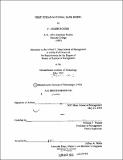| dc.contributor.advisor | William F. Pounds. | en_US |
| dc.contributor.author | Rogers, F. Joseph (Frederick Joseph), 1963- | en_US |
| dc.contributor.other | Sloan School of Management. | en_US |
| dc.date.accessioned | 2009-08-26T17:22:10Z | |
| dc.date.available | 2009-08-26T17:22:10Z | |
| dc.date.copyright | 1993 | en_US |
| dc.date.issued | 2002 | en_US |
| dc.identifier.uri | http://hdl.handle.net/1721.1/46688 | |
| dc.description | Thesis (S.M.)--Massachusetts Institute of Technology, Sloan School of Management, February 2002. | en_US |
| dc.description | Includes bibliographical references (leaves 132-134). | en_US |
| dc.description.abstract | This thesis presents the organizational model of a hypothetical national black bank holding company, the First Nubian National Bank, as an agent of constructive consolidation and enhanced capital market efficiency within the industry of historically black-owned banks (HBBs). In the U.S., the history of slavery, segregation and legal discrimination against African-Americans drove the creation of several parallel service industries for Black consumers who were refused service by whites. Although "Free persons of color" had been involved in banking since the 1600s, the U.S. Congress actually created the Black banking industry by chartering the Freedman's Bank in 1865. The magnitude of Freedman's nationwide failure in 1874 led to the development of a fragmented black banking industry made up of many small, community-based institutions located throughout the southern United States and in most major urban clusters. Between 1888-1930 at least 134 such institutions were founded in the U.S. Today only 55 remain of which 38 are commercial banks. The pace of consolidation has been quickened first by integration, then by significant customer defections to larger, major-market banks, and most recently by the rapidly changing competitive nature of the banking industry. Recently HBBs have been plagued by high transaction costs, unusually high non-interest expense, and little financial innovation. This thesis analyzes how a national bank holding company could resolve these issues by leveraging the cost structure of larger, major market banks to capture synergies and economies. The model can help affiliated HBBs improve their operating efficiency, their delivery of products and services, and the overall performance of their roles as financial intermediaries in the capital market systems of their target communities. | en_US |
| dc.description.statementofresponsibility | by F. Joseph Rogers. | en_US |
| dc.format.extent | 134 leaves | en_US |
| dc.language.iso | eng | en_US |
| dc.publisher | Massachusetts Institute of Technology | en_US |
| dc.rights | M.I.T. theses are protected by
copyright. They may be viewed from this source for any purpose, but
reproduction or distribution in any format is prohibited without written
permission. See provided URL for inquiries about permission. | en_US |
| dc.rights.uri | http://dspace.mit.edu/handle/1721.1/7582 | en_US |
| dc.subject | Sloan School of Management. | en_US |
| dc.title | First Nubian National Bank model | en_US |
| dc.type | Thesis | en_US |
| dc.description.degree | S.M. | en_US |
| dc.contributor.department | Sloan School of Management | |
| dc.identifier.oclc | 50627526 | en_US |
